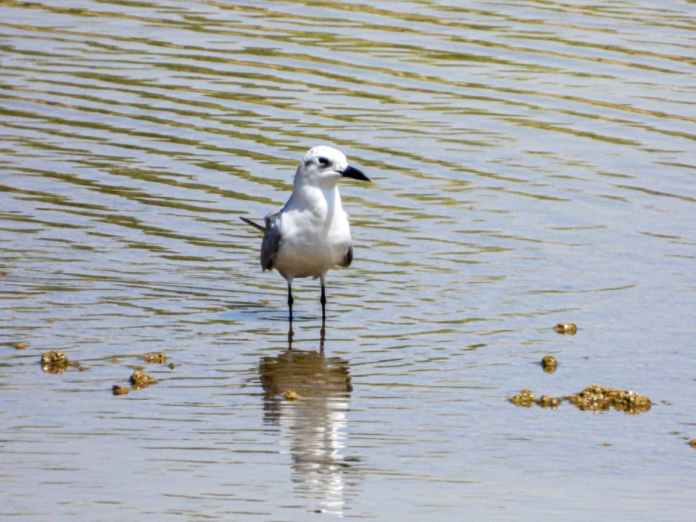On a warm September morning at Aammiq Wetland—the largest remaining freshwater marsh in Lebanon—wildlife photographer and SPNL Birdwatcher Chadi Saad caught a fleeting trio in perfect light: Gull-billed Tern, White-winged Tern, and Whiskered Tern. The images distill what Aammiq does best in early autumn: turn migration into a living classroom.
A meeting place on the flyway
Cradled in the West Bekaa, Aammiq sits on one of the world’s great migration corridors, where reedbeds, open pools, and flooded meadows offer exactly what traveling terns need: calm water, insect hatches, and room to rest. Over 250 bird species are recorded here, and the site is recognized internationally as an Important Bird Area and Ramsar wetland.
The sightings
Gull-billed Tern (Gelochelidon nilotica)

Chunkier than most terns, the Gull-billed carries a stout, dark bill made for versatility. Unlike plunge-diving relatives, it often hawks insects over fields and marsh edges, or takes small prey off the surface—behavior that makes Aammiq’s mosaic of water and agriculture ideal on passage. Globally, the species has an extremely large range and is assessed as Least Concern, with key populations spanning Europe, Africa, and Asia.
Why September at Aammiq? Post-breeding birds disperse broadly; along the East Mediterranean they drop into wetlands to refuel on emergent insects—exactly the buffet Chadi’s photos suggest.
White-winged Tern (Chlidonias leucopterus)

A shimmering study in transformation, White-winged Terns move between black-and-white breeding garb and sleek grey-and-white non-breeding tones seen on migration. They feed daintily over shallow water, picking insects and tiny fish—classic marsh-tern behavior. BirdLife lists the species as Least Concern with a vast Palearctic-to-Afrotropical migration, and regular passage through the Levant.
Why this matters at Aammiq: Early September aligns with peak southbound movement; mixed flocks often sweep low over reedbeds after storm fronts—precisely the moments a patient lens can freeze.
Whiskered Tern (Chlidonias hybrida)

Closer to water, heavier-bodied than its white-winged cousin, the Whiskered Tern favors reed-rimmed pools and flooded fields, often dipping for insects or pattering the surface. It’s globally Least Concern, with strong European and West Asian contingents that use eastern Mediterranean wetlands as stepping-stones to Africa.
Field cue at a glance: In late summer/early autumn, look for the dark cap with a smudged ear-covert patch and clean grey mantle; birds gather over wide, shallow basins like Aammiq’s open pools.
The eye behind the frame: Chadi Saad

Chadi isn’t just a photographer; he’s a storyteller and the manager of SPNL’s Hima Hammana Raptor Observatory, where education, community, and conservation meet. His SPNL features chronicle Mount Lebanon’s wildlife and weave folklore with field craft—skills that bring quiet species and quiet places to life.
Aammiq’s quiet power
Aammiq’s significance is cumulative: every autumn flock, every shimmer of tern-wings over the reeds, affirms why conserving Lebanon’s last great freshwater wetland matters—for birds pushed onward by ancient routes, and for the communities learning to celebrate and safeguard those routes.
Fast facts (from BirdLife Data Zone)
-
Gull-billed Tern—wide global range; marshes, lagoons, and adjacent fields; versatile aerial feeder; Least Concern. BirdLife DataZone
-
White-winged Tern—Palearctic breeder, Afrotropical winterer; prefers shallow, vegetated wetlands; Least Concern. BirdLife DataZone
-
Whiskered Tern—colonial in season, marsh-centric year-round; uses eastern Mediterranean wetlands on passage; Least Concern. Birdife DataZone
-
Aammiq Wetland—Lebanon’s largest natural freshwater wetland; IBA & Ramsar site; >250 bird species recorded. BirdLife DataZone
Credit
Photographs: Chadi Saad / SPNL (Aammiq Wetland, 6 September 2025).






